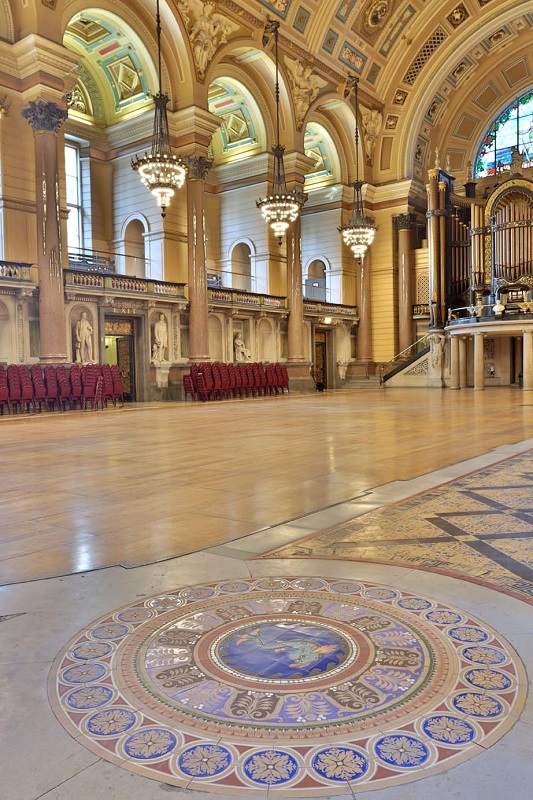St. George’s Hall, Liverpool is regarded as one of the finest examples of a Neo-Classical building in the world.
When constructed in the 1850s, the intricate encaustic tiled floor was the largest Minton pavement in the world at over 30,000 individual pieces.
Today, the tiled floor is undergoing major restoration and the first stage is successfully completed. The complexity of the original Minton design makes this project one of the most exacting ever undertaken by the UK specialist tile manufacturer Craven Dunnill Jackfield.

Harvey Lonsdale Elmes, a London architect aged just 25, won a competition to design the original Hall, along with the new assizes court. Construction started in 1841: the building opened in 1854. Magnificently decorated, the Great Hall is part of St. George’s Hall and features a barrel vaulted ceiling, stained glass windows, bronze doors, glittering chandeliers and the elaborate, Minton tiled floor. The floor depicts Liverpool’s history and is littered with maritime and classical imagery, including Liver Birds, Neptune, sea nymphs, dolphins and tridents. Located in the maritime mercantile area of the city, St. George’s Hall is part of the UNESCO Liverpool Heritage Site.
Alan Smith, Manager of St. George’s Hall has overseen the project. “The hall is the emotional heart of the city of Liverpool, where people look to congregate in good times and bad," he said.
"The sunken Minton floor features over 30,000 encaustic tiles and since its installation in 1854 has been largely covered up. The majority of the tiles have therefore been preserved in excellent condition but the periphery has been worn away through regular footfall. In recent years, the entire floor has been revealed more frequently and the whole of the Great Hall bursts into colour, light and splendour, making a magnificent cultural experience.”
Craven Dunnill Jackfield is the only company in the world capable of manufacturing such complex encaustic tiles, using traditional hand processes and skills to achieve tiles that match the original Minton tiles. The complexity of the project is hugely demanding; hand-carving the tile moulds for the project alone took several months, whilst each tile is individually hand-pressed and cut to size before firing.
At the outset Chris Cox from Craven Dunnill Jackfield visited the site to meticulously measure and photograph each panel, concentric ring and individual tile. Pantone references, referred to as clay/inlay test samples, were also matched for each of the 14 colours.

Back at Craven Dunnill Jackfield’s factory at Ironbridge, the photographs were rectified to the correct size and printed for reference and then magnified onto acetate. These were used as artwork for the mould-making stage. Blank moulds were individually cast and 24 hand-carved, precisely copying the minute detail of the artwork. The mould-making process took several months; accuracy at this stage is fundamental to the success of the project.
The individual tiles were hand-pressed, incorporating the relevant colours as slip or clay inlays. The tiles were then hand cut to size and fettled before firing, the latter taking two days. Once fired, the tiles were once again hand cut to size and fitted together, carefully checking the final dimension of the decorated panel exactly matched the original. They were then carefully packed and transported to site to be fitted.
The replacement tiles are manufactured using vitreous clays of low porosity. These replicate the look of the originals but will prove stronger and more durable than the Minton originals.
Chris Cox, a specialist ceramist at Craven Dunnill Jackfield led the project. “One of the most taxing aspects was the hand-cutting of the roundel tiles, which had to take place before firing in order to achieve the exact curvature required. After some experimentation final templates were created for each tile, resulting in the tiles fitting together with the minimum of mortar joint.”
In 2007, St. George’s Hall was reopened after a £23m refurbishment project. Since then, separate fund-raising efforts have taken place in order to restore five of the seven Minton roundel panels and tiled walkway which frame the Great Hall, the tiles of which have dramatically worn.
Craven Dunnill Jackfield has now completed the first stage, successfully manufacturing replacement tiles for the one of the panels, returning it to the original, gloriously rich colours. Alan Smith reports: “It has been a real delight to be able to call on the outstanding professionals at Jackfield and to see their exacting and high quality workmanship revive this iconic floor”.





















